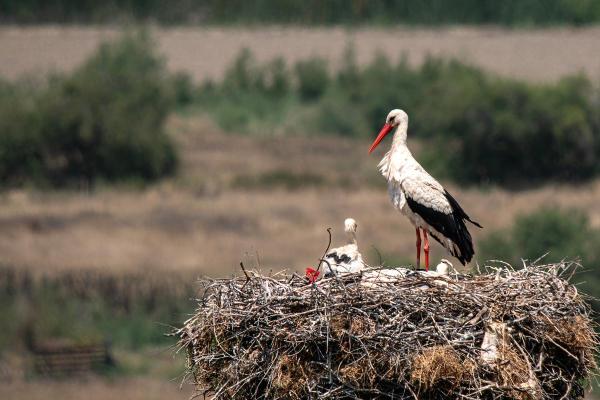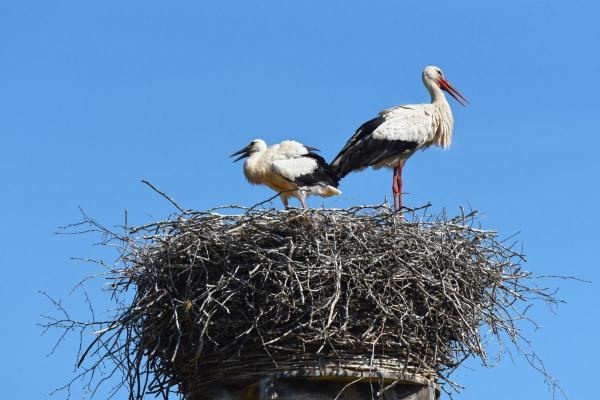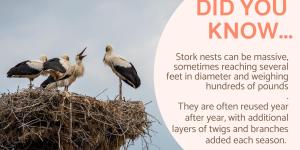Why Do Storks Kill Their Young?


Storks are a variety of bird species which make up the family Ciconiidae, but not all are known to carry out infanticide. The killing of their young is most commonly associated with the white stork (Ciconia ciconia). As with all storks, the white stork has a long body with a similarly elongated neck and legs. While it is particularly associated with Europe, the white stork has the widest distribution of any stork species. They are carnivorous birds whose diet will depend on availability, but they will eat insects, amphibians, small mammals and even the chicks of other birds. However, it is the consumption of eating their own chicks which leads AnimalWised to ask why do storks kill their young?
We look into detail the possible reasons why storks carry out brood reduction. It is important to note that storks do not always kill their young, but it is important to understand why some do at certain times.
Do storks kill their young?
Some storks are known to kill their young. From a cultural perspective, this may seem somewhat ironic. Historically, many cultures have associated the stork with fertility. Folklore from many European countries claimed that storks would bring newborn babies to families after finding them in nature. They are also known for their protective instincts, with many legends claiming they bestow luck on to homes and buildings.
Despite this association with fertility and good fortune, storks are one of the relatively few bird species which are known to carry out parental infanticide. However, it is very important to know that it is not true that storks always kill their young. Nor is it a phenomenon recorded in all stork species. In fact, it is only a very small minority of storks and birds in general that do so. Storks in which parental infanticide has been observed include:
- White stork (Ciconia ciconia)
- Black stork (Ciconia nigra)
- Wood stork (Mycteria americana)
- Marabou stork (Leptoptilos crumenifer)
While the killing of young in storks is a type of parental infanticide, it is known scientifically as brood reduction. This means the brood of young in a nest is reduced in size, but it is uncommon for the bird to kill the entire nest. The result is a type of selective killing.
Although it can be difficult for us to understand, several species of birds have been documented in nature using this strategy. Some parents resort to brood reduction when conditions are extremely adverse, doing so in order to increase the chances that certain chicks can survive and develop properly.
Self-preservation is a strong instinct in storks. For this reason, brood reduction seems counterproductive. It is important not to view this as a moral behavior. Storks will only carry it out when circumstances demand it. These conditions make it impossible to keep all the offspring. This is a form of natural selection intended to ensure the survival of the species.
You may not have already been aware of brood reduction and the killing of the young in storks. Now that you are aware, you may be interested to find out other surprising facts about storks in our related article.

Why do storks kill their babies?
Brood reduction and infanticide occur in a variety of animal species, although it is relatively uncommon in birds. In the wild, parental infanticide is something which can be carried out by either both or one parent, although studies show it is most common for the male stork to carry it out[1]. This should be differentiated from animals eating the young of others. Storks can eat chicks or eggs from other birds, but this is not the same as brood reduction and the selective killing of their own young.
In some animals brood reduction can be a method of estrus induction in females. Males kill the offspring of other males that are no longer around to induce females to enter estrus again. The purpose is to allow them to mate again. This occurs in lions, gorillas and chimpanzees, thanks to their social structures. However, storks are monogamous animals and do not carry out brood reduction for this reason.
Generally speaking, the killing of young as a form of brood reduction in storks is carried out for the following reasons:
- Scarcity of resources: at certain times of year, it is normal for environmental conditions to affect the availability of food or other resources. This affects food webs in ecosystems, meaning storks and other animals are unable to survive on what is available. When a stork is faced with a lack of food, they may selectively kill some of their brood to ensure the survival of the others.
- Habitat changes: storks are known to choose breeding sites which have previously been proven successful, moving to a new nest if they have not been[2]. Problems can arise with these sites, posing a threat to the nest. Storks prefer close proximity to wetlands and studies have shown that brood reduction is lowest in these areas[3]. If the habitat is not ideal, brood reduction is more likely.
- Evolutionary strategy and long-term species perpetuation: rather than storks investing limited resources in all chicks, adults tend to focus on those that are most likely to become adults and be able to reproduce.
- Weak chick: if a chick is born underdeveloped, diseased or has some other impediment, it is possible the parent stork will kill them. Not only does this weak chick have a lesser chance of survival, potential contagion of disease to the other chicks can mean the parent wants to protect those that are still healthy.
- Clutch size: this is another factor that influences this behavior. Females can lay up to 6 eggs, but they do so asynchronously. This means they stagger the laying of the eggs and some hatch before others. Since older chicks are larger and usually better able to compete for food, younger chicks may be underdeveloped. In these cases, the parent bird may kill the weaker birds to ensure the rest of the clutch survives when environmental conditions are adverse.
Although it is common to observe competition between chicks in various birds, this behavior has not been identified in storks. The older chicks do not attack their younger siblings to prevent them from consuming the food available to the adults. Although they may compete for food, siblicide has not been conclusively recorded in storks.
In this way, brood reduction in storks is a behavior that occurs only if there are adverse stress conditions that force them to resort to infanticide. It is not a capricious act, nor widespread in the group. It does not always happen, but is an adaptive behavior that allows the natural perpetuation of the species in nature. It should result in strong and resistant individuals with a good reproductive capacity.
For the proper development of the individual, sufficient quantities of quality food are needed. If these resources are scarce, this aspect cannot be met if there are many chicks to feed.
Brood reduction can occur in different species, not only storks. Learn more about this behavior in our articles on why does a dog kill her puppies and why do guinea pigs eat their young?
If you want to read similar articles to Why Do Storks Kill Their Young?, we recommend you visit our Facts about the animal kingdom category.
1. Tortosa, F. S. (1992). Motives for Parental Infanticide in White Storks Ciconia ciconia. Ornis Scandinavica, 23, 185-189.
https://www.researchgate.net/publication/232749681_Motives_for_Parental_Infanticide_in_White_Storks_Ciconia_ciconia
2. Bialas, J. T., Siekiera, J., Siekiera, A., Chromik, W., Dylewski, Ł., & Tobolka, M. (2023). Age, brood fate, and territory quality affect nest-site fidelity in white stork Ciconia ciconia. Frontiers in zoology, 20(1), 33. https://doi.org/10.1186/s12983-023-00506-y
3. Nowakowski, J. (2003). Habitat Structure and Breeding Parameters of the White Stork Ciconia ciconia in the Kolno Upland (NE Poland). Acta Ornithologica, 38, 39-46.
https://www.researchgate.net/publication/235889533_Habitat_Structure_and_Breeding_Parameters_of_the_White_Stork_Ciconia_ciconia_in_the_Kolno_Upland_NE_Poland






